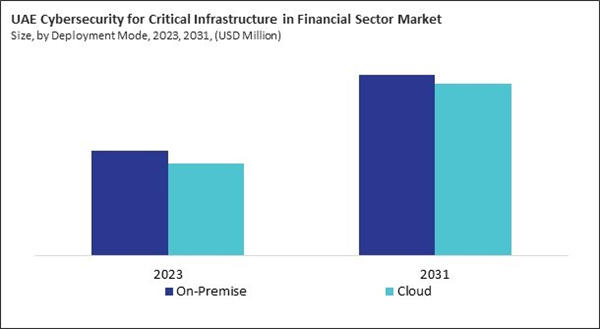The Latin America, Middle East and Africa Cybersecurity for Critical Infrastructure in Financial Sector Market is expected to witness market growth of 8.2% CAGR during the forecast period (2024-2031).
The Brazil market dominated the LAMEA Cybersecurity for Critical Infrastructure in Financial Sector Market by country in 2023, and is expected to continue to be a dominant market till 2031; thereby, achieving a market value of $271.8 Million by 2031. The Argentina market is showcasing a CAGR of 9.1% during 2024-2031. Additionally, the UAE market would register a CAGR of 7.8% during 2024-2031.
Financial institutions operate in a highly regulated environment. Regulatory authorities such as the Federal Reserve (U.S.), European Central Bank (EU), and financial watchdogs in various countries have stringent requirements for protecting financial systems. These include mandates for data protection, cybersecurity frameworks, and reporting incidents of cybersecurity breaches.
Financial institutions are heavily invested in managing operational risks, and cybersecurity threats are one of the largest sources of concern. Cyber risk management frameworks help institutions assess vulnerabilities, mitigate potential threats, and develop contingency plans. Adopting comprehensive cybersecurity strategies ensures a proactive approach to addressing these risks.
The growing adoption of fintech in the UAE and the rapid growth of AI and automation in Brazil has significantly impacted the cybersecurity landscape, particularly within critical infrastructure for the financial sector. These developments influence market growth by intensifying the need for enhanced security protocols and advanced technologies to protect financial services and infrastructures. The UAE’s leadership in the fintech sector, as evidenced by the substantial growth in investments, reaching USD 2.5 billion by 2022, has elevated the demand for cybersecurity solutions in the financial sector. In Brazil, the accelerated growth of AI and automation technologies, coupled with a significant increase in spending on Intelligent Process Automation (IPA) and IaaS/PaaS, has contributed to the expanding complexity and scale of digital financial operations. In conclusion, both the UAE and Brazil’s rapid developments in fintech and AI have created a dynamic demand for cybersecurity solutions, particularly in the critical infrastructure of the financial sector.
The Brazil market dominated the LAMEA Cybersecurity for Critical Infrastructure in Financial Sector Market by country in 2023, and is expected to continue to be a dominant market till 2031; thereby, achieving a market value of $271.8 Million by 2031. The Argentina market is showcasing a CAGR of 9.1% during 2024-2031. Additionally, the UAE market would register a CAGR of 7.8% during 2024-2031.
Financial institutions operate in a highly regulated environment. Regulatory authorities such as the Federal Reserve (U.S.), European Central Bank (EU), and financial watchdogs in various countries have stringent requirements for protecting financial systems. These include mandates for data protection, cybersecurity frameworks, and reporting incidents of cybersecurity breaches.
Financial institutions are heavily invested in managing operational risks, and cybersecurity threats are one of the largest sources of concern. Cyber risk management frameworks help institutions assess vulnerabilities, mitigate potential threats, and develop contingency plans. Adopting comprehensive cybersecurity strategies ensures a proactive approach to addressing these risks.
The growing adoption of fintech in the UAE and the rapid growth of AI and automation in Brazil has significantly impacted the cybersecurity landscape, particularly within critical infrastructure for the financial sector. These developments influence market growth by intensifying the need for enhanced security protocols and advanced technologies to protect financial services and infrastructures. The UAE’s leadership in the fintech sector, as evidenced by the substantial growth in investments, reaching USD 2.5 billion by 2022, has elevated the demand for cybersecurity solutions in the financial sector. In Brazil, the accelerated growth of AI and automation technologies, coupled with a significant increase in spending on Intelligent Process Automation (IPA) and IaaS/PaaS, has contributed to the expanding complexity and scale of digital financial operations. In conclusion, both the UAE and Brazil’s rapid developments in fintech and AI have created a dynamic demand for cybersecurity solutions, particularly in the critical infrastructure of the financial sector.
List of Key Companies Profiled
- Cisco Systems, Inc.
- IBM Corporation
- Fortinet, Inc.
- Palo Alto Networks, Inc.
- Check Point Software Technologies Ltd.
- Trend Micro, Inc.
- Huawei Technologies Co., Ltd. (Huawei Investment & Holding Co., Ltd.)
- Broadcom, Inc.
- Schneider Electric SE
- Honeywell International, Inc.
Market Report Segmentation
By Deployment Mode
- On-Premise
- Cloud
By Industry
- Fintech
- Banking
- Insurance
By Component
- Solution
- Service
By Country
- Brazil
- Argentina
- UAE
- Saudi Arabia
- South Africa
- Nigeria
- Rest of LAMEA
Table of Contents
Chapter 1. Market Scope & Methodology
Chapter 2. Market at a Glance
Chapter 3. Market Overview
Chapter 4. Competition Analysis - Global
Chapter 5. LAMEA Cybersecurity for Critical Infrastructure in Financial Sector Market by Deployment Mode
Chapter 6. LAMEA Cybersecurity for Critical Infrastructure in Financial Sector Market by Industry
Chapter 7. LAMEA Cybersecurity for Critical Infrastructure in Financial Sector Market by Component
Chapter 8. LAMEA Cybersecurity for Critical Infrastructure in Financial Sector Market by Country
Chapter 9. Company Profiles
Companies Mentioned
- Cisco Systems, Inc.
- IBM Corporation
- Fortinet, Inc.
- Palo Alto Networks, Inc.
- Check Point Software Technologies Ltd.
- Trend Micro, Inc.
- Huawei Technologies Co., Ltd. (Huawei Investment & Holding Co., Ltd.)
- Broadcom, Inc.
- Schneider Electric SE
- Honeywell International, Inc.
Methodology

LOADING...









